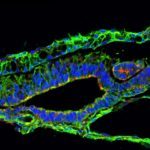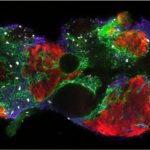Présentation
Abstract: Epithelia are planar tissues, separating the internal environment from the external environment in many organs. I will present two recent studies that examine the behaviour of cells within monolayers.
A major epithelial function is the directed absorption and excretion of nutrients, water, and ions in a process known as vectorial transport. When cultured on impermeable substrates, a manifestation of vectorial transport is the generation of multicellular blisters. We examined the interaction between cell mechanics, cell adhesion, and hydrodynamic phenomena that leads to dome formation. Blisters arise through the progressive accumulation of fluid into progressively larger dynamic fluid pockets trapped between the cells and the impermeable substrate leading to sub-cellular, cellular, and multi-cellular blisters. By examining the evolution of the average blister size, we show that dome growth can be understood through a common class of coarsening phenomena known as Ostwald ripening that underlies the evolution of droplet size in emulsions.
Cell competition is a quality control mechanism through which epithelia eliminate unfit cells. Cell competition can result from short-range biochemical inductions or long-range mechanical cues. However, little is known about how cell-scale interactions give rise to population shifts in tissues, due to the lack of experimental and computational tools to efficiently characterise interactions at the single-cell level. Here, we address these challenges by combining long-term automated microscopy with deep learning image analysis to decipher how single-cell behaviour determines tissue make-up during competition.”


